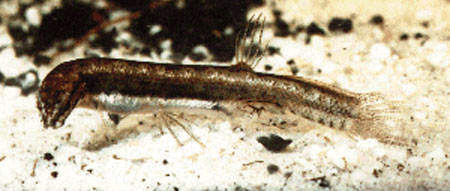| Lepidogalaxiidae (Salamanderfishes) |
| 7.4 cm SL (male/unsexed); 6.7 cm TL (female) |
|
demersal; freshwater; pH range: 3.79999995231628 - 4.5; dH range: 5, non-migratory |
| Oceania: endemic to Western Australia in seasonal pools between the Blackwood and Kent rivers. |
|
|
| Occurs in shallow streams, drains and temporary pools in generally acidic water around pH 4. Water typically is tea-coloured (Ref. 44894). Feeds mainly on aquatic insect larvae and small crustaceans. Spawn: late winter, early spring; internal fertilization (male with modified anal fin); female laying about 100 eggs. Rapid growth of hatchlings (reaching 2.5 cm by summer). Life cycle may be limited to 12 months. Young fish aestivates in pear-shaped burrow in mud until water returns in autumn. They have no accessory respiratory structures and cannot withstand low oxygen situations (Ref. 36499). About 25-30% of the population attains sexual maturity at the end of the first year. The breeding season coincides with heavy rains between late May and August. The lifespan typically lasts three years, but some fish persist for up to five years (Ref. 44894). |
|
Endangered (EN); Date assessed: 09 January 2019 (B1ab(i,ii,iii,iv)+2ab(i,ii,iii,iv)) Ref. (130435)
|
| harmless |
Source and more info: www.fishbase.org. For personal, classroom, and other internal use only. Not for publication.
